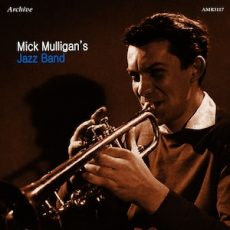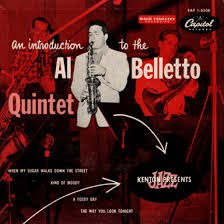
Daily Dose Of Jazz…
Peter Sidney Mulligan who was known by Mick, was born on January 24, 1928 in Harrow, Middlesex, England. He began playing trumpet while a student at Merchant Taylors’ School, Northwood and entered into the family wine company, but became an alcoholic and eventually was pushed out of the business by his relatives.
Forming his Magnolia Jazz Band in 1948, he met George Melly soon afterwards and they became close associates who performed together for many years. Mulligan’s orchestra included Roy Crimmins, Ian Christie, and Archie Semple that rivalled Humphrey Lyttelton’s band in popularity on the British trad jazz circuit.
While he booked excellent side men, Mick was not a top-flight musician and his own playing was often hampered by intoxication; their recording legacy is spotty because their releases were irregular and generally for small labels. He and Melly’s antics were drunken and scandalous outings, making them regular tabloid figures in the 1950s.
Breaking up his band in 1953 he reformed it a year and a half later, continuing with the new group into 1962 and was part of the biggest trad jazz event to be staged in Britain at Alexandra Palace. By the early 1960s, rock and roll had whittled the enthusiasm for trad jazz to nearly nothing and Mulligan disbanded the Magnolia Jazz Band. He went on to manage Melly, who was launching a solo career. He played occasionally into the 1970s, but mostly retired to run a grocery store. Later in life he became interested in horse racing, and owned or part-owned several race horses, including the prize-winning horse, Forever My Lord.
Trumpeter and bandleader Mick Mulligan, who was best known for his presence on the trad jazz scene, suffered a stroke at age 78 and died in Chichester, West Sussex, England on December 20, 2006.
More Posts: bandleader,history,instrumental,jazz,music,trumpet

Daily Dose Of Jazz…
Stanley Brian Reynolds was born on January 16, 1926 in Lincoln, England. He began his musical career when he toured with the Tommy Sampson Orchestra at age 14. By 1948, he was playing with Ted Heath and His Music, and from the 1950s, he also worked with Vic Lewis, Dave Shepherd, Kenny Baker, Johnny Keating, Louie Bellson and Buddy Rich.
As a session musician, he was involved as a soloist on the Beatles’ White Album with a trumpet solo in Martha My Dear. In 1975, under his own name he created his own big band album, The Greatest Swing Band in the World…is British (PYE).
In the 1980s, he worked with Barbara Thompson and Chris Smith. In the field of jazz he was involved in 84 recording sessions between 1948 and 1989,
Trumpeter Stan Reynolds died on April 14, 2018. at age 92.
More Posts: bandleader,history,instrumental,jazz,music,trumpet

Daily Dose Of Jazz…
Werner Dies was born on January 15, 1928 in Frankfurt, Germany. An autodidact on guitar and saxophone, he studied clarinet and composition starting in 1947. From 1947 to 1955 he played guitar in the dance band of Willy Berking, and was a member of the bands Hotclub Combo and Two Beat Stompers.
He led his own ensemble, went on a tour of Yugoslavia in 1955 and from 1955 to 1965 he was a member of Hazy Osterwald’s sextet, and also worked as a session musician and arranger. He toured with Joe Turner and, in 1968, Charly Antolini.
He had a hit in Germany in 1954 with Schuster bleib bei deinen Leisten (The Little Shoemaker) that spent eight weeks at #1 on the German hit parade starting in October 1954. He later worked for Howard Carpendale, Adam & Eve, Graham Bonney, and other singers, and produced easy listening music with his own ensemble, the Werner Dies Sax Band.
He wrote a treatise on clarinet improvisation that was published in 1967. He produced the group Bläck Fööss from 1973 to 2003. Tenor saxophonist, clarinetist, guitarist, composer, and arranger Werner Dies died on February 5, 2003.
More Posts: arranger,bandleader,clarinet,composer,guitar,history,instrumental,jazz,music,saxophone

Daily Dose Of Jazz…
Johnny Varro was born January 11, 1930 in Brooklyn, New York and began studying piano at the age of ten. During his teenage years, he was introduced to jazz by way of the Commodore Music Shop in New York City. There he met the manager Jack Crystal, father of Billy Crystal, who was running jam sessions on the Lower East Side. At these sessions he met Willie “The Lion” Smith, Big Sid Catlett, Joe Thomas, Hot Lips Page, Joe Sullivan, Pete Brown and others. The experience of sitting in for Joe Sullivan and Willie “The Lion” Smith was invaluable and soon allowed Johnny to become a hired player.
His first professional job was with Bobby Hackett touring the East Coast with his quartet. In 1954 he worked at Nick’s with Phil Napoleon and later with Pee Wee Erwin. In 1957 Eddie Condon asked Johnny to play at his club as intermission pianist, which led to his becoming Eddie’s band pianist.
For the next several years between the Condon tours, Varro worked most of the jazz rooms around New York City before moving to Miami in 1965 to work on the Jackie Gleason Show. He toured with the Dukes of Dixieland, then moved to Los Angeles, California, where he lived, played and toured for the next 14 years. He created the swing group covering the styles of the ’30s, ’40s, and ’50s called Swing 7.
Pianist Johnny Varro, who has recorded some two dozen albums, made a final move to Tampa Bay, Florida in the early Nineties, where he continues to play jazz festivals, jazz parties and concerts around Europe and the United States.
More Posts: bandleader,history,instrumental,jazz,music,piano

Daily Dose Of Jazz…
Al Belletto was born on January 3, 1928 and raised in New Orleans, Louisiana. He graduated from Warren Easton Charter High School before entering Loyola University New Orleans studying music and then earning a master’s degree from Louisiana State University.
Belletto played with Sharkey Bonano, Louis Prima, Wingy Manone and the Dukes of Dixieland in the 1940s and 1950s. He went on to lead his own band and record several albums on Capitol Records from 1952. Along with his ensemble they became part of Woody Herman’s band for U. S. State Department tours of South America in 1958 and 1959.
In the Sixtiess, Al worked at the New Orleans Playboy Club fronting the house band and serving as Musical/Entertainment Director, booking nationally known acts into the venue.
Saxophonist and clarinetist Al Belletto, who recorded six albums as a leader, died on December 26, 2014 in Metairie, Louisiana.
More Posts: bandleader,clarinet,history,instrumental,jazz,music,saxophone


